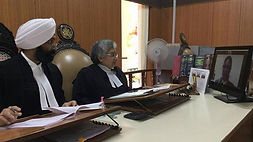POLITY
Digital Justice

Context:
● A department-related Standing Committee on Personnel, Public Grievances, Law and Justice Friday suggested that virtual court proceedingsshould be allowed to continue even after the coronavirus pandemic ends, and that necessary changes in the law should be made to facilitate this.
● The Supreme Court of India has been conducting hearings online via video conferencing due to Covid-19 Pandemic. Also, recently the High Court of Gujarat has allowed the live streaming of its proceedings.
Probable Question:
What are various benefits and challenges associated with the digitalisation of the justice system? Suggest some measures.
Benefits:
● It will enhance access to justice and improve the justice system with greater speed in disposing of cases.
➢ There are 3.1 crore cases pending in the lower courts, 44 lakh in the high courts, and 60,000 cases pending in the Supreme Court (the figures are as of 2019).
● Overcome the geographical barrier: It will allow litigants and lawyers to access the judicial system, even from the remotest parts of India.
● As the system becomes more robust and artificial intelligence more proficient, justice will become more accessible and affordable to the poorest and those living in remote areas.
● There will also be other hidden and indirect benefits — for instance, the creation of efficiencies, less stress on physical infrastructure, lesser crowding in courts, lesser waiting time in the court corridor, more productive use of time, fewer cars on the road, and improved work-life balance.
● Virtual courts also cut the exhaustive paperwork and cost of manpoweras they are replaced with electronic records and automated workflows.
● Digital justice ensures the safety of vulnerable witnesses providing testimony, expedites processes and procedures and are an improvement over traditional courts as they are most affordable, citizen-friendly and offer greater access to justice
Challenges:
● Internet Connectivity: It is the biggest challenge in implementing the live proceedings of Courts. Counsels, advisors, and Litigants may not have adequate Internet speed and accessibility to participate in an online Video Conference.
● Making available any document to the Court/tribunal, especially related to proposed issues, case laws, circulars/notifications, and other additional evidence would not be an easy task.
● This may further exacerbate the digital divide in India and inequity in accessing justice.
● Recording of evidence and cross-examination over video conferencing would also be a cumbersome task.
● Cybersecurity risks, especially in legal matters that involve sharing personal, confidential data.
● Challenges of language barriers are there because access to the internet is still predominantly by English.
● Data storage issues are also fraught with challenges as currently, the data would be housed in the home ministry. Some experts have raised concern over housing the data under the home ministry with the possibility of surveillance.
● Digital justice delivery software is complex and Local Courts may find difficulty in the adoption of new and evolving technologies.
● The demeanour of witnesses/accused: Some experts claim cross-examination in a virtual court may not be as effective as the one during an open court hearing.
Suggestions:
● Infrastructure, especially internet connectivity should be improved. The government should step up efforts to ensure timely implementation of the National Broadband mission.
● Digital India initiativemust be broadened to include awareness campaigns to drive digital and legal literacy, specifically for marginalised groups.
● A robust cybersecurity mechanism should be placed to prevent cyber-attack on judicial system databases.
Conclusion:
The entire system of justice needs to be restructured and re-innovated around the digital tools so as to ensure quick and effective delivery of justice to the aggrieved without much delay.
Although digitalisation improves the delivery of justice, issues related to digital technology solutions need careful analysis and an overhauling of both laws and existing systems before they are introduced.